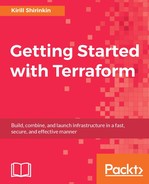This was the largest and perhaps most important chapter so far! All these new infrastructure tools are useless if we don't know how to use them in production.
Now we know how to scale our Terraform resources with count and how to work around lack of conditional statements in HashiCorp Configuration Language with the help of the count property. You learned how to reference resources grouped with count, how to target them, and how to provisioner them properly. We also discovered a few more useful functions of Terraform.
Most importantly, you learned what Immutable Infrastructure is and what benefits it brings along to the modern operations. With the theory in hand, we taught ourselves how to use yet another HashiCorp tool named Packer and created a few AMIs with it. And, as we know that Terraform is perfect for Immutable Infrastructure, we took a deep look at multiple ways to do upgrades of complete instances. We did it manually, we did it with self-written scripts and we also did it with Auto-scaling groups of AWS. Finally, you also learned how to put existing infrastructure under Terraform's control with the refresh and import commands and an external terraforming utility.
It feels like we are all set up to rule the complete infrastructure with the help of Terraform, from development to production environments! There is one more thing though: it's a rare case that only one person works on everything in a company, thus collaboration on infrastructure is also a very important topic that you should learn about. In the next chapter, we will figure out how to work with Terraform templates in a team, how to roll out updates without having conflicts with other people's work, and how to implement a complete Continuous Integration cycle for Terraform-managed infrastructure.
